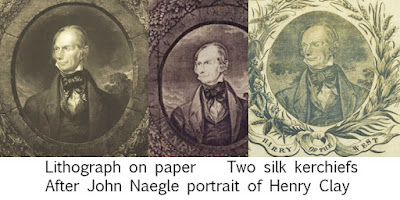Quilt combining portraits of two Whigs, Henry Clay, Zachary Taylor, plus founding father George Washington with the patchwork design we call Whig's Defeat. It was auctioned a few years ago.
The Clay portrait is probably cut from a kerchief similar to these two drawn after a popular lithograph, probably done in Philadelphia in 1844.
The portrait of Zachary Taylor seems to be in a similar medium, a lithograph adapted to fabric, although I don't find the portrait in a casual search. It shows Taylor with a horse and a soldier, probably one of his heroic images after winning a large battle in the Mexican War, which qualified him to be the Whig's candidate in the 1848 election, grabbing the party's nomination from Clay who was the early favorite.
Zachary Taylor was elected President in 1848.
He died in office from a fever during 1850, a cholera year.
The flag with 31 stars is hard to see in the photo.
The quilt was first pictured in the Safford & Bishop book
America's Quilts & Coverlets.
It was in the collection of Foster & Muriel McCarl, collectors who loaned several quilts to Safford & Bishop for photography.
The caption tells us:
"c. 1850, 79" x 77"....The following poem is inscribed in ink underneath the flag, which is embroidered with thirty-one stars:
As long as they waves shall gleam in the Sun.The lines are part of a poem that seems to have been runner-up in a September, 1850, contest conducted by P.T. Barnum for a song to be sung by Jenny Lind. "Salutation to America" by Epes Sargent was thought better than the winning song and was widely published in the fall of 1850. Although it had been published as early as 1844, the words were in the air two months after Taylor died.
And long as thy Heroes remember their Scars
Be the hands of Thy Children united as one.
And peace shed her Light on the Banner of Stars
Hail! Thy Republic of Washington, Hail!
Never may Star of thy Union wax pale.
Hope of the World! may each Omen of ill
Fade in the light of thy Destiny still."
Sargent's poem has nothing to do
with either Taylor or Clay as far as I can understand.
Similar pattern construction but
a later quilt if we use the strip border
and the fugitive tan cotton as clues to date/
My first thought was that the quilt at the top of the page is a pro-Henry Clay quilt until I thought about the patchwork pattern, Whig's Defeat. Clay was the face of the party and if any Whig was defeated it was Clay, over and over. He ran unsuccessfully in 1824, 1832, 1840 & 1844. In 1848 he hoped to be the Whig candidate and lost to Whig Taylor who won the November election.
Dating the quilt:
The quilt would have to have been made after the summer of 1848 when Taylor became the candidate. Could it have been a mourning quilt for Taylor made after the Jenny Lind Song contest in 1850? Or one made to mourn both Taylor & Clay after Clay's death in the summer of 1852.
One other clue is the 31 stars in the flag. Thirty-one was the proper number from July 4, 1851 to July 3, 1858, another indication this quilt was made after Taylor's death and perhaps after Clay's.
I'm guessing after 1850.
If you can't get enough of the Whigs see this article:











Interesting quilts. Henry Clay was a great American, an anti-slavery southerner, lawyer, legislator and The Great Compromiser. He could not be elected, IMHO, because sectionalists rejected his reasonable intellectual philosophy. Had become president, this country might well have been spared the war.
ReplyDelete